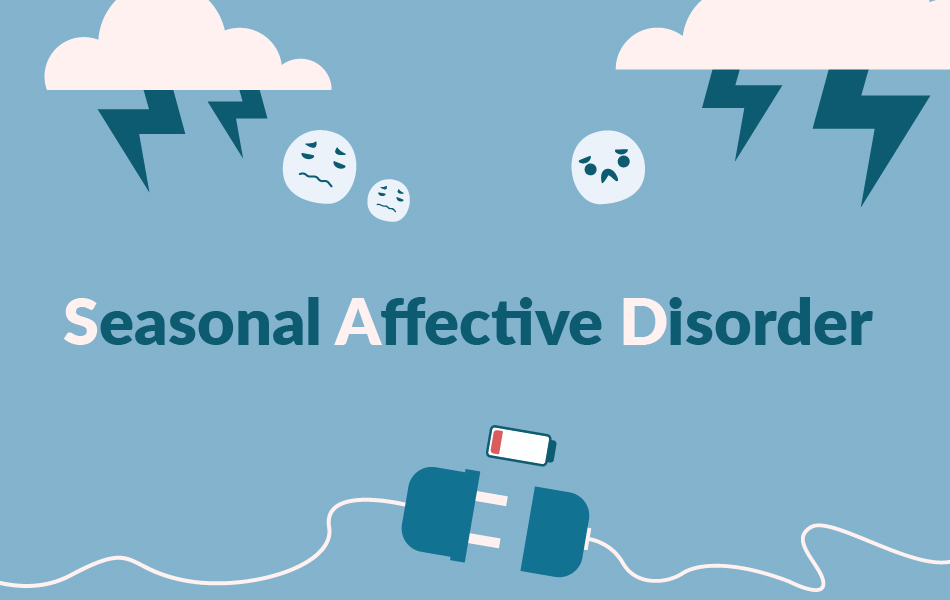At the start of autumn and winter, we experience shorter daylight and colder temperatures
Subsequently, it can trigger decreased motivation, interest loss, fatigue, and low moods
When it comes to the holidays, some individuals may feel more stressed, burnt out, and tend to sleep less and overeat, which results in unwanted weight gain.
Moreover, the financial burdens, social gatherings and the pressure to feel energised or joyfully spirited when in reality, you feel depressed can trigger holiday anxiety or holiday blues.
Generally speaking, most adults struggle with social anxiety during the holidays and may turn to unhealthy habits as a coping mechanism. Some may even love the holidays and feel extreme sadness and depression-like symptoms after the holidays.
Holiday anxiety, holiday blues and seasonal affective disorder (SAD) all mimic the signs and symptoms of depression. Therefore, it is critical to know the difference in order to know when to seek help from a professional.
Seasonal affective disorder, which is also known as “the winter blues,” usually starts in the colder months and resolves during the warmer seasons. SAD is not specified as a mental health problem but as “a seasonal pattern.”
Even though SAD is more common in the wintery months, known as Winter SAD, it may occur during the spring and summer, known as Spring SAD. The onset of winter SAD is generally more common and often characterises atypical depression symptoms, such as increased appetite, carbohydrate cravings or insomnia.

The Differences Between SAD and Depression
Depression is a clinical mood disorder that a mental health specialist diagnosed. It may affect children and adults for a longer period of time.
The symptoms of depression should be present for more than two weeks and not have any connection with the change of seasons or temperatures. Moreover, these symptoms may cause noticeable distress in social and occupational functioning.
Seasonal Affective Disorder (SAD)
It’s normal to feel down occasionally; many people may experience the “winter blues” when the seasons get colder. However, you should be aware of the symptoms to know when you need to speak to a professional. Some of these symptoms include:
- Depressed moods on a daily basis.
- Lack of interest in activities once enjoyed.
- Decreased energy.
- Difficulty concentrating or focusing.
- Sleep disturbances or oversleeping.
- Feelings of hopelessness or worthlessness.
- Negative thoughts.
- Unwanted weight gain.
- Anxiety
- Increased agitation or Irritability
Depression
Depression, formally known as clinical depression, causes an individual to feel extremely low moods all the time. Several factors, such as stressful life events, may cause it.
Mental health specialists define depression as a condition if you experience any of the following symptoms for two weeks or more:
- Extremely low moods
- Feeling unworthy or hopeless
- Feelings of persistent guilt
- Lack of interest in usual activities
- Persistent tiredness
- Difficulty concentrating or focusing.
- Feeling restless.
- Constant forgetfulness or difficulty making decisions.
- Unexplained weight gain or loss.
- Sleeping too much or too little.
As you can see, depression and seasonal affective disorders have similar symptoms. However, a doctor can distinguish between the two through the timing of when the symptoms have started. An individual may be diagnosed with SAD if:
- Symptoms start or worsen in the autumn or early winter seasons.
- The intensity of symptoms in the colder months outweighs nonseasonal symptoms.
- You’ve experienced these symptoms in a seasonal pattern for two or more consecutive years.
The Causes of Seasonal Affective Disorder
Researchers have not established what exactly causes seasonal depression. Although, some theories suggest that the following can trigger SAD:
Biological clock change: Your biological clock changes when there is less sunlight. Therefore, it regulates your mood, sleep and hormones. Once these changes take place, you may be out of your regular routine with the daily schedule. At the same time, you struggle to adjust to the changes in daylight length.
Brain chemical imbalance: If you are at risk of SAD, you may have a decrease in Serotonin hormones (which contributes to feelings of happiness). Since sunlight helps to regulate serotonin, the lack of sunlight in the winter may trigger feelings of depression.
Deficits in Vitamin D: Vitamin D also helps to boost serotonin levels. Sunlight helps with producing vitamin D, whereas the lack of sun in the winter may lead to vitamin D deficiency. These changes may also affect your serotonin levels and your moods.
Melatonin Boost: The chemical that affects your sleep patterns and moods. The lack of sunlight may also stimulate an overproduction of melatonin levels. Due to this, you may feel sluggish and persistent fatigue during the colder seasons.
Negative Thoughts: In general, those who struggle with the seasonal affective disorder may often experience stress, anxiety and negative thoughts.

How SAD is Treated
The seasonal affective disorder may feel draining or overwhelming, but there are several treatment options that are effective. There are four main categories which mental health specialists recommend using alone or as a combination, such as:
Light therapy
This treatment aims to expose individuals struggling with SAD to a bright light every day. You sit in front of a bright light of 10,000 lux daily for 20 to 45 minutes. Generally, you do this first thing in the morning. Therefore, helping to improve serotonin levels.
Psychotherapy (Talk Therapy)
Talk therapy is formally known as cognitive behavioural therapy (CBT), which aims to help individuals learn how to cope with certain situations. Also, it focuses on replacing negative thoughts with more positive thoughts.
Antidepressant Medication
Doctors also recommend the use of antidepressants called selective serotonin reuptake inhibitors (SSRIs) to treat SAD symptoms once they occur. The medication significantly improves the individual’s mood.
Many healthcare specialists recommend you talk to your healthcare provider about which treatment options suit your needs. For those who are seeking help, we have compiled a list of questions to ask a healthcare provider if you are uncertain about what you should ask them concerning SAD:
1. What is the best treatment option for my needs?
2. How can I prevent having depressive episodes?
3. Will light therapy work for me?
4. Will I need antidepressants?
5. When must I start my treatment process?
6. How long will my treatment be?
7. What diet should I follow to improve my symptoms?
8. What else can I do to feel better?
How to take care of yourself if you have SAD
As mentioned in the previous section, you should speak with your healthcare provider. When you plan ahead, it may make it easier for you to manage your symptoms and feel your ultimate best.
Below are the Dos and Don’ts for taking care of yourself when recovering from seasonal affective disorder:
DO:
- Please stick to your treatment plans: When your healthcare provider prescribes medication for SAD, you should use them as directed. If you don’t see an improvement in your symptoms, you should follow up with your healthcare provider to adjust your treatment plan.
- Take care of yourself: Ensure that you eat a well-balanced diet, get enough sleep and exercise regularly. You can also try to manage your stress healthily by talking to a therapist.
- Plan ahead: Create a plan of action for what you will do if your symptoms get worse. When you notice signs or symptoms of depression, take action. Planning various activities and having a busy schedule may help keep you from lounging down at home, which will help you avoid falling into depressive moods.
- Start your treatment early: Speak to your therapist about preventative treatment. If you are aware that your symptoms start at a certain time of the year, consider starting your treatment before. For example, if you notice that your symptoms appear in June, start your treatment plan in May.
Don’t:
- Isolate yourself from others: Even though you may feel like you don’t want to go out or be social, try to reach out to friends or family. When you are alone, it may worsen your symptoms.
- Indulge yourself in unhealthy habits: When you turn to unhealthy habits as a coping mechanism, it may worsen your symptoms and can interact negatively with medications.

As debilitating as a seasonal affective disorder may seem, it usually lasts only a few weeks. The most important thing to do is look after yourself throughout this healing process.
In spite of the struggle, you can live a satisfying and purposeful life. Depression should not be suffered alone in silence, and there is no shame in seeking help from a loved one or from a healthcare professional.
When you’re feeling at your lowest, opening up might seem nearly impossible, but acceptance and sharing are the first and most significant steps towards healing.
The courage it takes to share your experience always pays off – through the support of loved ones and the guidance of mental health professionals who understand your condition.
Providing the highest level of care is our top priority at ZwavelStream Clinic. We understand the internal struggle that sometimes plagues people suffering from depression. For more information or if you require depression treatment, please don’t hesitate to contact us.







